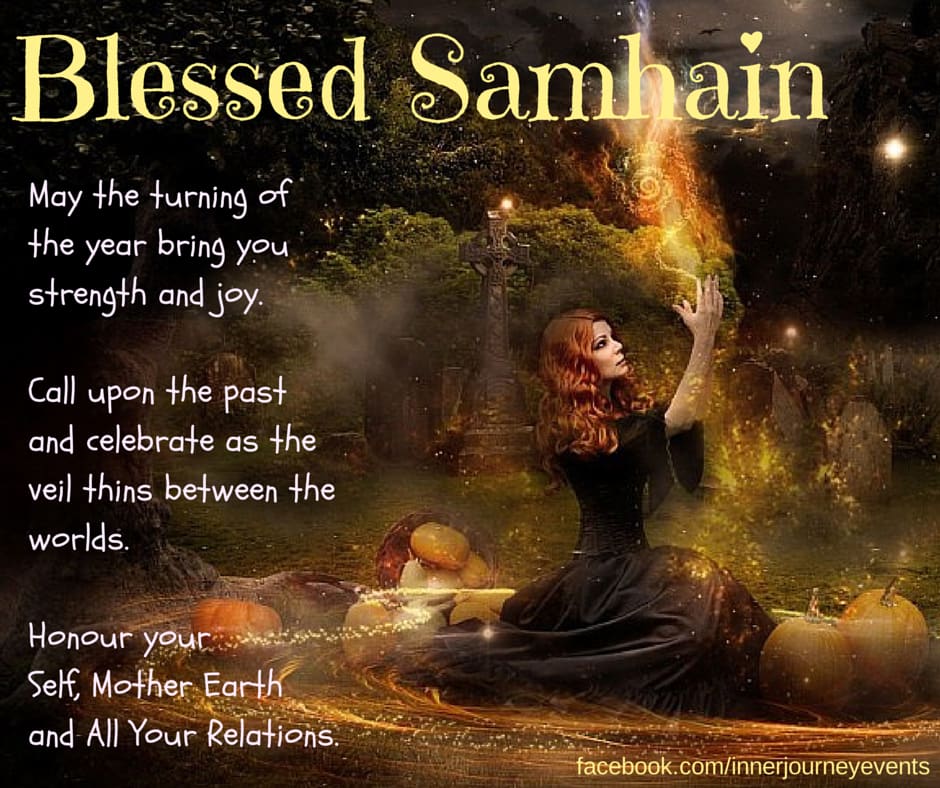2016年10月16日(Sun.) 爽やかな秋晴れの一日でした。ショッピング・センターでは、特設コーナーでハロウィーン・グッズが並べられているのが目立っていましたが、皆さんもこの催しを楽しみにしていらっしゃるのでしょうか。 (私は、さほどの楽しみには思っていません。ただ、文化的に関心があることは否定しません。)
そこで、ケルティックな面から、関連の情報を少しさぐってみました。
( ニュースソース: https://rikpotter.com/2011/10/23/samhain/ )
当ブログの、今年(2016年)7月31日には Lughnasa (8月の意味)について、そして、9月25日には Mabon (秋分の意味)について取り上げています。 そして、今回は Samhain に関することになります。
<原文の一部>
Magical Holidays: Samhain
Samhain (pronounced sow-win) is an ancient Celtic festival that is still celebrated today by Witches, Wiccans, Druids and other magical folk. The word Samhain means “Summer’s End”, and takes place on October 31st. In fact, the ancient festival was a 3-day period that began on October 30 and ended November 1st. In Scottish Gaelic, ‘Samhain’ is the word for November, and is the Celtic New Year. This holiday has many layers of meaning. To the ancient Celts, it was the third and last harvest festival, which meant that Summer was indeed over, and it was time to prepare for the cold, dark winter ahead.
(抜粋)Samhain (発音: sow-win )は、古(いにしえ)のケルティック・フェスティバルであり、現代においても、魔女や、多神教、ドルイド(信仰)などによって執り行われています。 Samhain の意味は「夏の終り」であり、10月31日に催されています。 実際は、古き祭りにおいては、3日間かけており、10月30日から始まり、11月1日に終わるものなのです。 スコットランド(注: UKの北部)のゲール語では、Samhain は11月を意味しており、ケルトの新年を意味するものでもあります。 この祝日は様々な意味を持っているのです。 古のケルト人にとっては、3度目で且つ最後の収穫祭であり、夏の終りを告げるものでもあります。そして、寒さと暗い冬に向うための準備をするタイミングでもあるのです。
・・・
Many traditions of Halloween, such as lighting pumpkins and dressing in costume, have their origins in the festival of Samhain. The Gaelic custom of wearing costumes and masks was an attempt to confuse evil spirits or placate them. In Scotland the dead were impersonated by young men with masked, veiled or blackened faces, dressed in white. Candle lanterns carved from turnips were part of the traditional festival. Large turnips were hollowed out, carved with faces, and placed in windows to ward off evil spirits. This later evolved into the carving of pumpkins. Children going door to door in costumes and masks carrying turnip lanterns, offering entertainment of various sorts in return for food or coins, was traditional in 19th century, and continued well into 20th century. This evolved into the “Trick or Treat” custom of today’s Halloween.
(抜粋)ハロウィーンの多くの伝統、例えば、カボチャ・ランタンとか、変装・仮装したりする、これの原型は Samhain から来ています。 ゲール人の慣習では、仮装することは邪悪な精神を困惑させたり、または、なだめようとするものなのです。 スコットランドでは、若い男性がマスクをして、ベールをかぶるか、顔を黒くして、白装束に身を包んで、死を表現します。 カブを彫刻して作ったキャンドル・ランタンは伝統の祭りの一部になります。 大きなカブはくり抜かれ、顔のように彫刻され、窓際に置いて悪霊を追い払うのです。 これが、後にはカボチャの彫刻に進化しました。 子供達は仮装してランタンを持ち、家から家を回り、食べ物やお金と引き換えに、様々な余興を提供します。 それは、19世紀の伝統で、20世紀になっても続けられています。 そして今日、“Trick or Treat”と言うハロウィーンの習慣に進化しました。
What is today called Halloween, is derived from “All Hallows Even”, or the night before “All Hallows Day”, which is November 1st. These were later Christianized into “All Saints Day” and “All Souls Day“ (November 2nd), days to honor Christians who have died. ・・・
(抜粋)ハロウィーン( Halloween )は、“All Hallows Even”からか、または、"All Hallows Day”(11月1日)の前夜の意味から来ています。 これは後に“All Saints Day”や“All Souls Day“ (November 2nd)になって行きました。 ・・・
***
全文を訳してはいませんが、ハロウィーンと Samhain の関係のあらましは分るのではないでしょうか。 収穫を祝い、新年を迎えると言うケルティックな文化が、今日に伝わっていると言えるのでしょうね。
*
2013年の10月末、ドイツのブレーメンに宿泊していて、市内を散策した後のホテルに戻る夜道で、とある家の玄関前で子供達がハロウィーンの伝統を楽しんでいるのを見かけたことを思い出しました。
良いとか悪いとかではなく、こうした伝統や文化もあることを認め合うことが 「多文化共生」 につながることではないでしょうか。 但し、人権や尊厳を損なうかのような悪しき慣習からは脱却すべきでしょう。



*
ところで、今日は新潟県知事選が行われているようです。 知事を選んでいると言うことなのでしょうが、第三者の私からは、原発再稼動を認めないとする県民が多いのか、それとも、原発マネーに依存しようとする人々が多いのか・・・。 その点に注視しています。
*** 下の写真は、記事内容とは関係ありません。

***
そこで、ケルティックな面から、関連の情報を少しさぐってみました。
( ニュースソース: https://rikpotter.com/2011/10/23/samhain/ )
当ブログの、今年(2016年)7月31日には Lughnasa (8月の意味)について、そして、9月25日には Mabon (秋分の意味)について取り上げています。 そして、今回は Samhain に関することになります。
<原文の一部>
Magical Holidays: Samhain
Samhain (pronounced sow-win) is an ancient Celtic festival that is still celebrated today by Witches, Wiccans, Druids and other magical folk. The word Samhain means “Summer’s End”, and takes place on October 31st. In fact, the ancient festival was a 3-day period that began on October 30 and ended November 1st. In Scottish Gaelic, ‘Samhain’ is the word for November, and is the Celtic New Year. This holiday has many layers of meaning. To the ancient Celts, it was the third and last harvest festival, which meant that Summer was indeed over, and it was time to prepare for the cold, dark winter ahead.
(抜粋)Samhain (発音: sow-win )は、古(いにしえ)のケルティック・フェスティバルであり、現代においても、魔女や、多神教、ドルイド(信仰)などによって執り行われています。 Samhain の意味は「夏の終り」であり、10月31日に催されています。 実際は、古き祭りにおいては、3日間かけており、10月30日から始まり、11月1日に終わるものなのです。 スコットランド(注: UKの北部)のゲール語では、Samhain は11月を意味しており、ケルトの新年を意味するものでもあります。 この祝日は様々な意味を持っているのです。 古のケルト人にとっては、3度目で且つ最後の収穫祭であり、夏の終りを告げるものでもあります。そして、寒さと暗い冬に向うための準備をするタイミングでもあるのです。
・・・
Many traditions of Halloween, such as lighting pumpkins and dressing in costume, have their origins in the festival of Samhain. The Gaelic custom of wearing costumes and masks was an attempt to confuse evil spirits or placate them. In Scotland the dead were impersonated by young men with masked, veiled or blackened faces, dressed in white. Candle lanterns carved from turnips were part of the traditional festival. Large turnips were hollowed out, carved with faces, and placed in windows to ward off evil spirits. This later evolved into the carving of pumpkins. Children going door to door in costumes and masks carrying turnip lanterns, offering entertainment of various sorts in return for food or coins, was traditional in 19th century, and continued well into 20th century. This evolved into the “Trick or Treat” custom of today’s Halloween.
(抜粋)ハロウィーンの多くの伝統、例えば、カボチャ・ランタンとか、変装・仮装したりする、これの原型は Samhain から来ています。 ゲール人の慣習では、仮装することは邪悪な精神を困惑させたり、または、なだめようとするものなのです。 スコットランドでは、若い男性がマスクをして、ベールをかぶるか、顔を黒くして、白装束に身を包んで、死を表現します。 カブを彫刻して作ったキャンドル・ランタンは伝統の祭りの一部になります。 大きなカブはくり抜かれ、顔のように彫刻され、窓際に置いて悪霊を追い払うのです。 これが、後にはカボチャの彫刻に進化しました。 子供達は仮装してランタンを持ち、家から家を回り、食べ物やお金と引き換えに、様々な余興を提供します。 それは、19世紀の伝統で、20世紀になっても続けられています。 そして今日、“Trick or Treat”と言うハロウィーンの習慣に進化しました。
What is today called Halloween, is derived from “All Hallows Even”, or the night before “All Hallows Day”, which is November 1st. These were later Christianized into “All Saints Day” and “All Souls Day“ (November 2nd), days to honor Christians who have died. ・・・
(抜粋)ハロウィーン( Halloween )は、“All Hallows Even”からか、または、"All Hallows Day”(11月1日)の前夜の意味から来ています。 これは後に“All Saints Day”や“All Souls Day“ (November 2nd)になって行きました。 ・・・
***
全文を訳してはいませんが、ハロウィーンと Samhain の関係のあらましは分るのではないでしょうか。 収穫を祝い、新年を迎えると言うケルティックな文化が、今日に伝わっていると言えるのでしょうね。
*
2013年の10月末、ドイツのブレーメンに宿泊していて、市内を散策した後のホテルに戻る夜道で、とある家の玄関前で子供達がハロウィーンの伝統を楽しんでいるのを見かけたことを思い出しました。
良いとか悪いとかではなく、こうした伝統や文化もあることを認め合うことが 「多文化共生」 につながることではないでしょうか。 但し、人権や尊厳を損なうかのような悪しき慣習からは脱却すべきでしょう。



*
ところで、今日は新潟県知事選が行われているようです。 知事を選んでいると言うことなのでしょうが、第三者の私からは、原発再稼動を認めないとする県民が多いのか、それとも、原発マネーに依存しようとする人々が多いのか・・・。 その点に注視しています。
*** 下の写真は、記事内容とは関係ありません。

***









